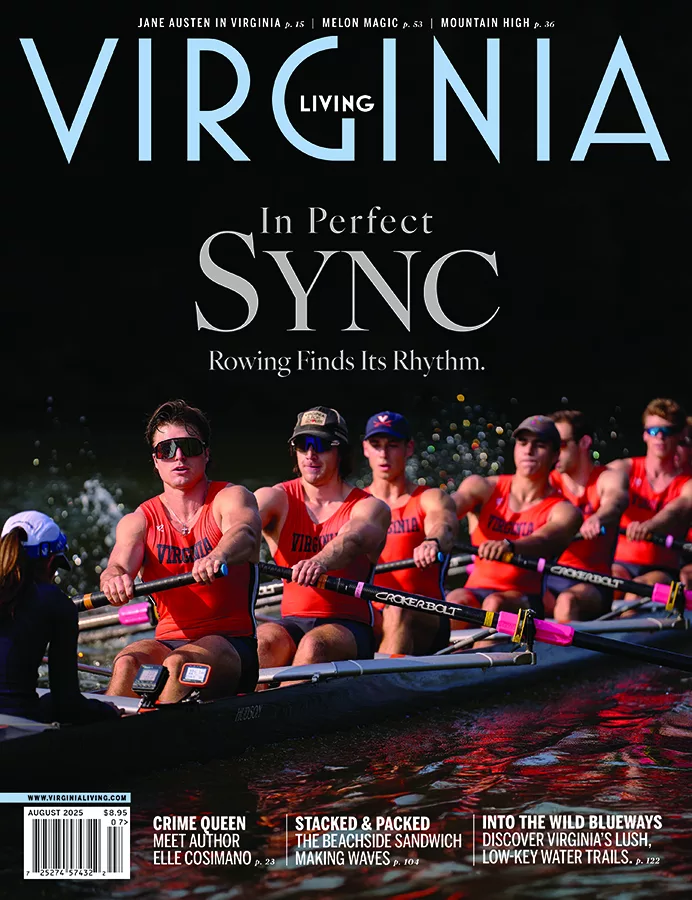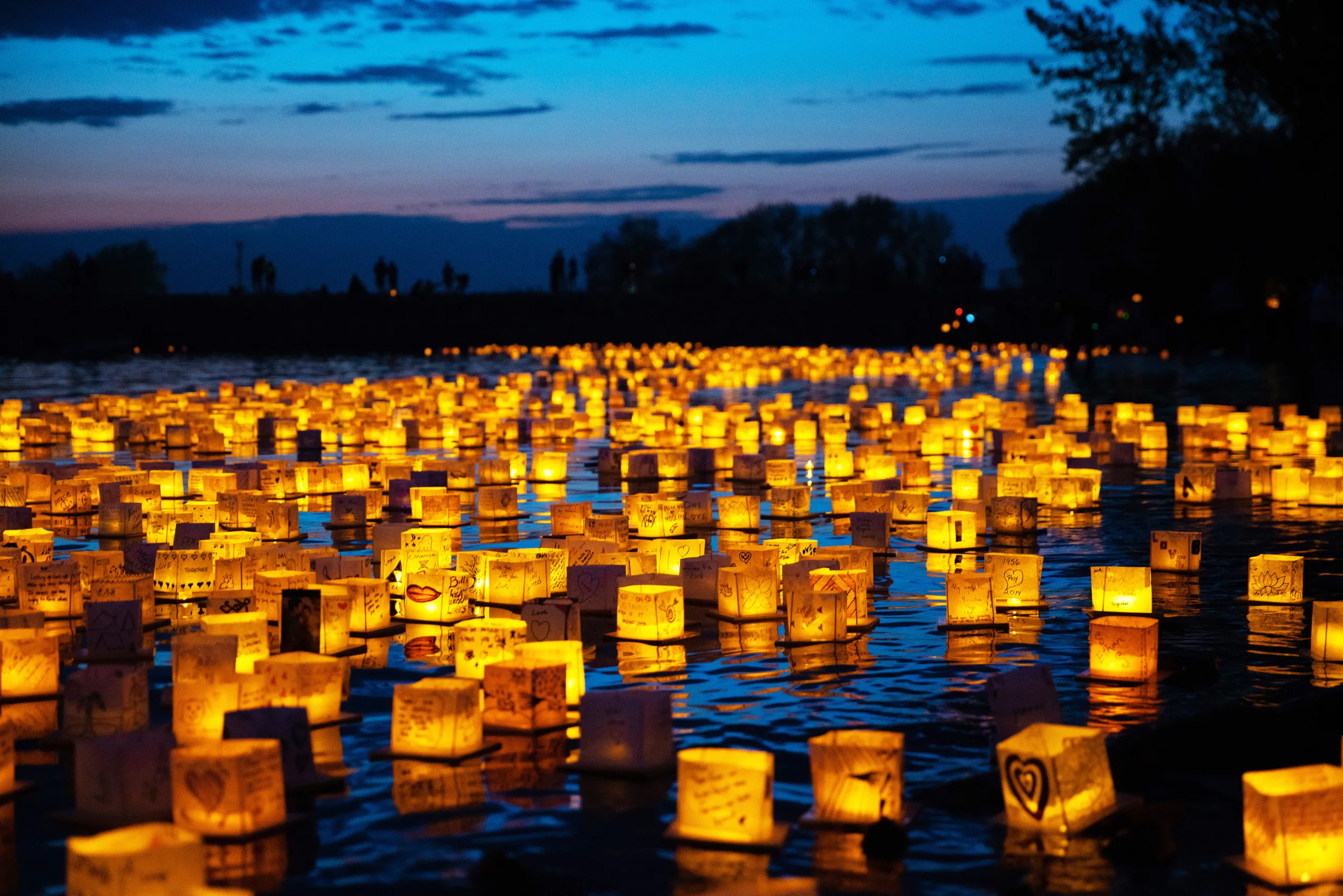A two-wheeled tour through history offers luxury and adventure.

(Anne Poarch of Basket & Bike; photography by Adam Ewing)
I first cycled the Virginia Capital Trail when it opened to much fanfare in 2015, and I was eager to see how it had evolved since then. The trail—which runs parallel to the James River, between Richmond and Jamestown—invites us to dwell with history while surrounded by natural beauty. And for me, that’s the point.
There’s something special about this 51.7-mile ribbon of blacktop—62 miles if you continue on to Williamsburg. And by all accounts, the Capital Trail has been a resounding success. “There were 1.2 million trail users last year, the biggest year ever,” Cat Anthony, executive director of the Capital Trail Foundation, tells me. The trail links urban and rural communities, providing an economic boost. And it has inspired others, including a planned Fall Line Trail, from Petersburg to Ashland, which will eventually connect to it.
The Capital Trail allows us to time travel to the place where the Powhatan Confederacy—a nation of more than 30 Algonquian-speaking tribes—flourished under the rule of Chief Powhatan. American colonists developed vast tobacco plantations on the James. And three wars were fought here—the Revolutionary War, the War of 1812, and the Civil War—forging, challenging, and preserving our budding nation.
The Starting Point

(Photography by Adam Ewing)
The unofficial trailhead lies just through a doorway in Richmond’s floodwall, beneath a stack of roads and train tracks rising above Shockoe Bottom. Setting out on a sunny morning, I rode past the site where the notorious Libby Prison stood during the Civil War followed by the Great Shiplock, part of the historic Kanawha Canal surveyed by George Washington. Whizzing alongside the James where the Confederate Navy built ironclads during the war, I felt a whiff of history tinged with adventure.
As I headed through Varina, it was good to see new life: Kul Wheels, a purveyor of electric bikes and bike tours, and a refurbished convenience store offering last-chance necessities. Here, you’ll pass Dorey Park followed by Four Mile Creek Park, another popular trailhead.
Grand Estates of the James
The trail serves as the back alley to the grand estates facing the James, with scores of historical markers to narrate. You’ll see Curles Neck, once home to Nathaniel Bacon, who famously rebelled, setting fire to Jamestown; while farther down the path is Shirley Plantation, the nation’s oldest family business, now in its tenth generation of Carters.
With 30 miles behind me, I pulled into Upper Shirley Vineyards, about a mile and a half south of the trail. This winery and tasting room overlooks the James and Presquile National Wildlife Refuge—a 1,300-acre island and eagle, heron, and osprey habitat.
Upper Shirley is a hub for Basket & Bike, one of the trail’s earliest small businesses. Owner Anne Poarch offers bike rentals and excursions and delivers picnics to her riders along the trail. She’s also been known to belt out a rousing version of “Amazing Grace” during stops at Westover Church. “I’m trying to get people to press pause,” she told me, “to smell the breeze blowing across the field and to see what’s around.” Poarch says the arrival of more small businesses—purveyors of food, lodging, and services—continues to enhance the trail experience.
I guiltlessly ordered Upper Shirley’s Route 5 Burger, version “2.0,” two patties of blended short rib, brisket, and chuck with American cheese and smoked bacon on toasted brioche. When I asked chef Carlisle Bannister what was in his signature “comeback sauce,” which united it all in a sumptuous warm glow, he only grinned.
Up next, Berkeley, site of the first Thanksgiving, is the birthplace of Benjamin Harrison—a signer of the Declaration of Independence—and his son William Henry Harrison, the nation’s ninth president. After that, it’s Westover, the Byrd family seat, where Cornwallis crossed the James in pursuit of Lafayette. I pedaled on toward Sherwood Forest, President John Tyler’s country home, whose grounds include Fort Pocahontas, the site of one of the Civil War’s fiercest battles between Black Union troops and the Confederate Army.
A Night at Eagles’ Watch Inn
Charles City, site of a 1730 courthouse, marks the trail’s midpoint and Cul’s Courthouse Grille, formerly the town’s general store, bank, post office, and ABC store, remains its epicenter. Here you might rub elbows with local luminaries like former governor Douglas Wilder or Chickahominy Chief Stephen Atkins while hoisting beverages with fellow trail riders. My wife Jessica met me here with the car, and I gulped down a large Arnold Palmer on the patio before we loaded up my bike and headed to the Inn at Eagles’ Watch, hoping to beat a looming storm.
At this recently opened inn, six miles north of Route 5, proprietor Jennifer Jones held forth in her chef’s kitchen as Jess and I, perched at the counter on bar stools, enjoyed a charcuterie board and wine and watched the storm pummel the Chickahominy River. Jones, a William & Mary graduate from Pittsburgh, had been looking to buy a B&B in Williamsburg when she found “love at first sight” in Eagles’ Watch, part of which dates back to 1685.
She’s transformed the place into a cozy inn by blending family antiques and art with a good dose of attentiveness and charm. During a dinner of delectably seasoned roasted chicken, I struck up a conversation with fellow guest Deneen Glennon, who’d come from outside Philly with her husband Patrick. They’d rented bikes at Upper Shirley and ridden seven miles out and back.
“I’m not a biker,” Glennon told me, “but I enjoyed it. I liked the markers you can stop and read. For someone who doesn’t ride, it was easy to ride and comfortable.” Glennon and I compared notes on our lunches. “I think it was the best burger I’ve ever had,” she said, “double brie, bacon jam, and the roll was really fresh.” Hers came from Indian Fields Tavern, a converted farmhouse about five miles east of Upper Shirley. Duly noted for a future ride.
The next morning, after a copious breakfast of eggs, bacon, airy biscuits, granola, and banana bread, I returned to the route with a sense that the trail is growing its own community. Crossing the Chickahominy on a high bridge, I got my first view of the James since leaving Richmond. It’s one of my few gripes about the route—to see more of America’s majestic first river, you’ll want to make off-trail detours.

(Photography by Adam Ewing)
Pressing on to Wedmore Place
As I neared Jamestown, Spoke & Art, a trailside café offering pastries, cookies, Blanchard’s coffee, and craft beers, invites riders with its rambling deck. With live music and bike facilities, it’s just the sort of trailside spot needed in Richmond.
I continued past Billsburg Brewery on the Jamestown Yacht Basin and, although I’d completed the trail, I hopped on the Colonial Parkway toward Wedmore Place, the European-style hotel at the Williamsburg Winery. Our incentive: an oyster roast followed by a couple’s massage.
After a missed exit and a dozen more miles, Jess and I were sampling raw oysters and sharing a flight of aromatic red blends. Another Basket & Bike hub, the winery offers vigorous massages by Thai practitioners skilled at renewing riders for the trail. As mine knee-walked across my hamstrings and back, I was most thankful.
Monday morning, day three, I was gratified to find route 617, the Colonial Parkway shortcut I’d missed. This turnoff allows you to ride seamlessly from Richmond to the winery avoiding any busy roads. From the parkway I could see Jamestown Island. I horseshoed around on an isthmus to get a closer view of the historic site before we boarded the Jamestown-Scotland Ferry by car and bike to soak up more history on the river’s south bank.
Crossing the river brought the water views I’d missed on the trail. The free, 20-minute passage took us to Surry County on the south side of the James. Riding up a steep hill, I caught up to a cyclist hauling serious panniers. When I asked if he’d ridden the Capital Trail, he responded, “Where’s that?” He was riding from Indianapolis to Florida via the Outer Banks. Humbled, I made my way to the Surry Seafood Co., where I met Jess and soothed my pride with a soft shell crab sandwich and a bowl of crab soup.
After lunch, we visited Smith Fort Plantation. Here, in 1609, Captain John Smith built a backup fort in case Jamestown was sacked. He was soon forced to abandon it to defend Jamestown—from rats—and never returned. Chief Powhatan gave the land to Pocahontas and John Rolfe as a wedding present. In the dappled light beneath towering sycamore and walnut trees, the view across the river to Jamestown from these diminished ramparts was serene, the vortex of history strong.
A Farmhouse B&B

(Photography by Adam Ewing)
On the last morning, I set out from Peace Hill Farm in Holdcroft, on the north side of the James. The 100-acre farm, once part of a royal land grant, was named for a 1614 treaty signed by Jamestown settlers and the Chickahominy. Now owned by author Susan Wise Bauer, whom the Washington Post called a home-schooling “force,” Peace Hill Farm includes a farmhouse B&B, a cottage converted from a henhouse, and its own church. Bauer raises Leicester Longwool sheep, Angora goats, and draft horses here, and guests can help care for the animals, pick peaches and apples, and fish in a trout pond.
Pedaling down Glebe Lane, I stopped at Piney Grove at Southall’s Plantation. Built circa 1800 as a one-story log corncrib, it was later converted into a store, and then a frame house. During the Civil War, Tom Harwood, the store’s clerk, carried the Confederate colors into battle at nearby Malvern Hill, only to be felled by cannon fire. Despite a shattered leg, Harwood managed to find his way to Piney Grove through pouring rain.
Tuesday is a day off for many of the rural restaurants along the trail, so we’d arranged for Basket & Bike to drop off a picnic at Edgewood, an 1849 Carpenter Gothic mansion with an even older gristmill. J.E.B. Stuart stopped here for a cup of joe in June 1862 on his daring ride to inform Lee about McClellan’s positions. Edgewood’s halls are roamed by the ghost of Lizzie Rowland, who lost her true love when he left to fight the Yankees. Our picnic came with a blanket and a vase of flowers, and we lounged on the lawn, far from Lizzie’s troubles.
From Edgewood, I rode toward Malvern Hill Farm, where I took a rutted country lane to Malvern Hill Battlefield. Here, in July 1862, Lee and McClellan squared off. The latter was forced to retreat from Richmond. Jess and I walked past gun emplacements and ruins and through woods so dense and convoluted that we worried we might not escape them before dark.
The walk in the woods was unplanned, but the trail, with its outsized power to catapult us back to our nation’s beginnings, offers adventures of all kinds. It was just one of the myriad ways time travel can unfold on the Capital Trail.

(Photography by Adam Ewing)
RIDING THE TRAIL?
Whether you’re riding a short stretch or conquering all 51.7 miles of the trail, you’ll find trip-planning advice on the Virginia Capital Trail Foundation website, VirginiaCapitalTrail.org. Other helpful travel tips:
BIKE RENTALS
Basket & Bike: Owner Anne Poarch offers bike rentals, excursions, and picnics for trail riders. Poarch shares space with RVA on Wheels in Richmond’s Shockoe Bottom at 1301 E. Cary St., 804-564-2568. BasketAndBike.com, RVAonWheels.com
Bike the Burg: Located near Williamsburg’s historic district, this shop offers bike rentals, sales, and service. Daily or weekly rentals. 515 York St., Williamsburg. 757-570-7326. BikeTheBurg.net
Kul Wheels: Electric bikes make riding the trail a breeze. Rent by the hour or the day, plus tours. 1106 New Market Rd., Richmond. 804-205-3452. KulWheels.com
Pedego Electric bike rentals and tours. 301 E. Cary St., Richmond. 804-343-1850. PedegoElectricBikes.com
TRAIL ACCESS AND PARKING
Jamestown Trailhead: Greensprings Park off State Route 31.
Williamsburg: Chickahominy Riverfront Park, 1350 John Tyler Memorial Hwy.
Charles City County Visitors Center: Park at 10760 Courthouse Rd.
Henrico County: Dorey Park, 2999 Darbytown Rd.
Varina: Parking is available at Four Mile Creek Park.
Richmond Riverfront: Park at Great Shiplock Park, Pear and Dock streets.
WHERE TO EAT AND DRINK

(Photography by Adam Ewing)
Upper Shirley Vineyards: The tasting room offers bistro dining in a spectacular setting. Live music most weekends. 600 Shirley Plantation Rd., Charles City. 804-829-9463. UpperShirley.com
Spoke & Art Provisions Co.: Stop here for sandwiches, pastries, and lattes. There’s a bike repair station for trail riders. 3449 John Tyler Hwy., Williamsburg. 757-808-5278. SpokeAndArt.com
Billsburg Brewery and its Hungry Pug Food Truck is surrounded by a marina with great water views. 2054 Jamestown Rd., Williamsburg. 757-926-0981. Billsburg.com
Indian Fields Tavern: Seasonal American fare in a farmhouse setting. Live music most weekends. 9220 John Tyler Memorial Hwy., Charles City. 804-829-2200. IndianFieldsTavern.com
WHERE TO STAY
Inn at Eagles’ Watch: This 17th-century inn offers elegant home-cooked meals with rooms to match, plus views of the Chickahominy River. 12500 Eagles Nest Rd., Charles City. 804-220-6316. InnAtEaglesWatch.com
The Bed & Breakfast at Peace Hill Farm: Working farm with guest rooms, meals, and farm activities. 18401 The Glebe Ln., Charles City. 757-771-1274. HistoricPeaceHill.com
Nance-Major House B&B: The six guestrooms here include two suites with jacuzzis. Bike rentals are available. Near the Nance-Major Store at 10811 Courthouse Rd., Charles City. 804-314-4903.
Piney Grove at Southall’s Plantation: Guest rooms at the 1857 Ladysmith House on this 1700s plantation feature modern conveniences with a pool on site. 16920 Southall Plantation Ln., Charles City. 804-829-2480. PineyGrove.com
HISTORIC SITES
Edgewood Plantation: Once part of Berkeley Plantation, Edgewood offers guest rooms, a pool, guided tours, and Victorian teas. 4800 John Tyler Memorial Hwy., Charles City. 804-829-2962. EdgewoodPlantation.com
Smith’s Fort Plantation: Captain John Smith’s 1609 “New Fort” features antique furnishings and guided tours. 217 Smith Fort Ln., Surry. 757-294-3872. PreservationVirginia.org
Shirley Plantation: Established in 1613, it’s Virginia’s first. Open daily for tours. 501 Shirley Plantation Rd., Charles City. 804-829-5121. HistoricShirley.com
Sherwood Forest: Home to President John Tyler from 1842-1862. Daily tours. 14501 John Tyler Memorial Hwy., Charles City. 804-829-5377. SherwoodForest.org
This article originally appeared in the April 2022 issue.








